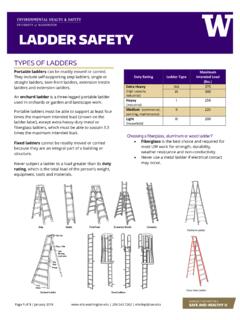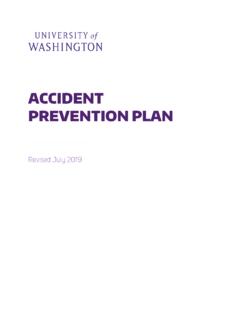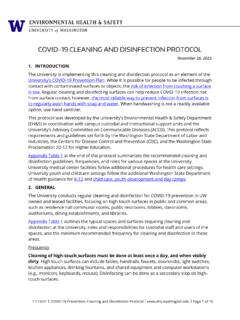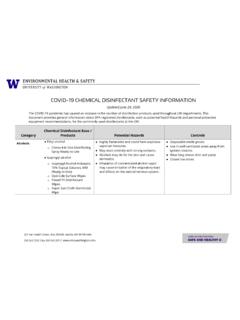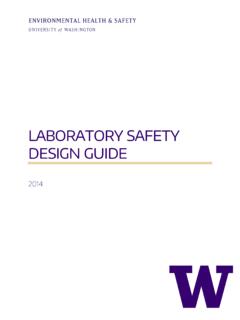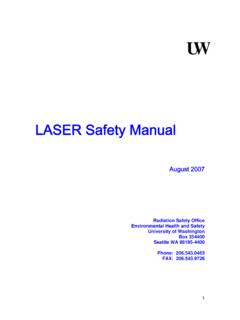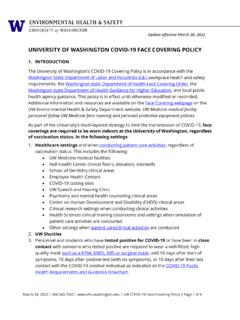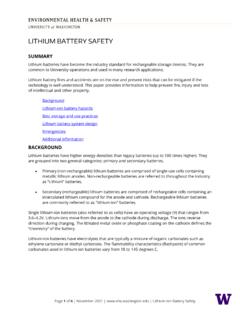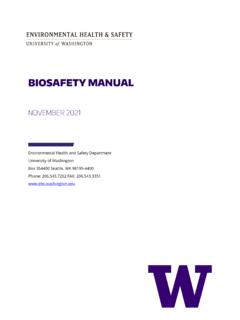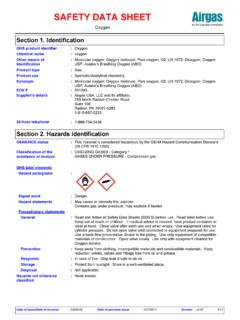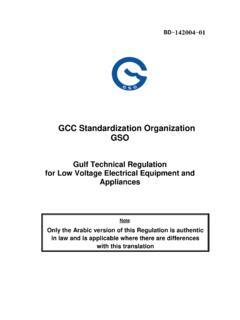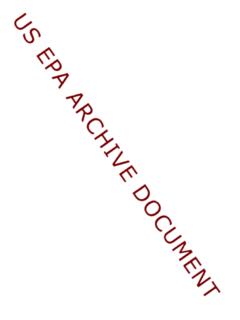Transcription of GUIDELINES FOR PERSONAL PROTECTIVE EQUIPMENT (PPE)
1 GUIDELINES FOR PERSONAL PROTECTIVE EQUIPMENT (PPE) JUNE 2020 TABLE OF CONTENTS Requirements .. 3 Hazard control .. 3 Supervisor responsibilities .. 4 How to Use This Guide .. 4 Step One: Assessment .. 5 Step Two: PPE Selection .. 5 Step Three: Training .. 5 Step Four: Documentation .. 5 Hazard Control and PPE .. 7 PPE Selection .. 12 Safe Use and Removal of PPE .. 32 Inspection, Maintenance and Storage .. 32 Sources for PPE .. 33 Resources .. 34 Appendix A: Welding Operation Shading Guide .. 35 Appendix B: Safety Shoes and Prescription Safety Glasses .. 36 Appendix C: Masks and Respirators Understanding the Difference .. 38 This is a guide to fulfill the minimum requirements and doesn t cover every conceivable hazard. If you need additional assistance in identifying engineering or administrative controls or in selecting PPE for a hazard, contact the EH&S Occupational Safety and Health Office at EH&S PPE GUIDELINES Occupational Safety & Health Revised 6/2020 Page 3 of 40 REQUIREMENTS The Washington State Department of Labor and Industries (L&I) in WAC 296 800 160 PERSONAL PROTECTIVE EQUIPMENT (PPE) requires all employers to assess their workplace for hazards that might require the use of PERSONAL PROTECTIVE EQUIPMENT .
2 If PPE has to be used, the supervisor must select the proper EQUIPMENT and require its use. HAZARD CONTROL Eliminating hazards through engineering or administrative control measures is the best way to protect people. The strategy used for the selection of controls is called the hierarchy of controls which prioritizes the types of controls that are most effective in eliminating or reducing the risk of exposure to the hazard. PPE is the least effective method for controlling or preventing exposure to a hazard. PPE provides a barrier to protect the worker from potential exposure to hazards, however due to the reliance on the worker to select, wear and maintain PPE, the likelihood of exposure to the hazard with PPE alone increases. EH&S PPE GUIDELINES Occupational Safety & Health Revised 6/2020 Page 4 of 40 In some cases, PPE is required by regulations or internal procedures and can provide an additional control to help protect the worker.
3 This guide will provide information and tools to assess PPE, manage and understand the limitations of PPE. SUPERVISOR RESPONSIBILITIES Each Supervisor has the responsibility to review all of their employees jobs for PPE needs. The regulations, the degree of hazard, and the engineering or administrative controls that are in place will determine what PPE is needed. If departments will be using PPE for personnel hazards, the following items must be completed: Assess the workplace for hazards Select appropriate PPE Ensure PPE is used Establish inspection, maintenance and replacement procedures to make sure damaged PPE is not used Train employees in proper use, limitations, care and maintenance of PPE Document assessment, selection, and training If all of the above mentioned items are documented in existing departmental procedures, such as a laboratory safety manual, departmental Standard Operating Procedures (SOPs) or Job Hazard Analyses (JHAs), for all employee worksites, then no further work is needed.
4 When the hazard assessment indicates that PPE is required, employing departments must provide the PPE to employees free of charge. Exceptions are prescription safety glasses and safety shoes. Where a hazard assessment determines that no PPE is needed, document the assessment and you re done. However, remember that if a hazard exists which does not require PPE, other regulations or programs may be applicable. Contact EH&S if you have questions or concerns. HOW TO USE THIS GUIDE This guide is designed to help departments and supervisors in the steps to assess their workplace, select the right EQUIPMENT , train employees and document this work. In addition, EH&S has developed the following PPE Tools for laboratories and shops to assist Principle Investigators (PIs), laboratory managers and shop supervisors in assessing and documenting hazards and appropriate PPE for their specific work areas.
5 Laboratory PPE Hazard Assessment Guide Shop PPE Hazard Assessment Guide EH&S PPE GUIDELINES Occupational Safety & Health Revised 6/2020 Page 5 of 40 Step One: Assessment Select the job, process or procedure you are going to assess. Survey the worksite and identify the hazards the worker will be exposed to while doing the work. Use one of the EH&S PPE Hazard Assessment Guides or a worksheet of your own to list the identified hazards. The HAZARD CONTROL AND PPE section below may help determine the hazards. Step Two: PPE Selection If PPE must be used, list the PPE that will be used for each hazard identified on your form. The supervisor or person completing the assessment and selection must sign and date the form. Step Three: Training After the assessment and selection, employees required to use PPE must be trained before they are required to use the PPE.
6 Retraining must be done if PPE requirements change and as needed. All of the following must be covered: What PPE to use and when to use it Limitations of the PPE How to put it on, take it off and adjust it Inspection and maintenance Any manufacturer instructions and warnings Make sure the PPE fits well How to obtain PPE How to dispose of PPE Step Four: Documentation The following information must be retained by University departments to document the PPE hazard assessment, PPE selection and training. Job, process, or activity being assessed Hazards identified Selection of PPE used for each hazard identified. PPE type, brand, model may need to be specified. Person(s) or job title identified to use PPE Name and title of person completing the hazard assessment Date hazard assessment was completed Name, title, training date for all employees required to wear PPE.
7 Forms are included in the laboratory and shop PPE hazard assessment guides. You may devise your own method for documenting these actions. Remember: Departments that record this information in existing policies or procedures may continue to use their current method and do not need to create new documentation for PPE. EH&S PPE GUIDELINES Occupational Safety & Health Revised 6/2020 Page 6 of 40 For example, laboratories write an SOP as part of their Chemical Hygiene Plan. A properly written SOP contains all of the needed information along with documentation of the employee training. Back to Top EH&S PPE GUIDELINES Occupational Safety & Health Revised 6/2020 Page 7 of 40 HAZARD CONTROL AND PPE This section provides an overview of exposure controls and PPE that may be needed for a variety of tasks that have potential hazards.
8 For specific task procedures and recommended controls in laboratories, consult the Laboratory Safety Manual; for Shops and Maintenance workers, consult the Facilities Services employee website. Laboratory worker Task(s) Potential Hazard Controls PPE Working with low hazard chemicals when a low probability of splash exists Skin and eye irritation Fume hood, local exhaust, good general ventilation, enclose process Safety glasses Light chemical resistant gloves Lab coat, closed shoes, long pants, long skirt or equivalent leg covering (no shorts) Working with smaller amounts (<1 liter) of corrosive or injurious chemicals where a reasonable probability of splash exists Skin and eye damage Bench top shield Chemical splash goggles Light chemical resistant gloves Lab coat, closed shoes, long pants, long skirt or equivalent leg covering (no shorts) Working with larger quantities of corrosive liquids (> 1 liter)
9 , or toxic corrosives Large surface area skin and eye damage Poisoning, or great potential for eye and skin damage Chemical splash goggles & face shield Appropriate heavy chemical resistant gloves Lab coat, closed shoes, long pants, long skirt or equivalent leg covering (no shorts) and chemical resistant apron Working with small volumes of organic solvents (< 1 liter) Skin and eye damage Slight poisoning potential through skin absorption Safety glasses, goggles if splash hazard exists Light chemical resistant gloves Lab coat, closed shoes, long pants, long skirt or equivalent leg covering (no shorts) Working with large volumes of organic solvents (> 1 liter), highly toxic organic solvents or work which may create a splash hazard Major skin and eye damage Potential poisoning through skin absorption Bench top shield Safety goggles & face shield Appropriate heavy chemical resistant gloves Lab coat, closed shoes, long pants, long skirt or equivalent leg covering (no shorts) and chemical resistant apron Working with small volumes of human blood, body fluids or other potentially infectious materials (OPIM) as defined in the UW Bloodborne Pathogen Exposure Control procedures Potentially infected with infectious disease (BBP) Potential spread of infectious disease Biological safety cabinet (BSC)
10 Safety glasses Disposable nitrile gloves Lab coat, closed shoes, long pants, long skirt or equivalent leg covering (no shorts) Working with large volumes of human blood, body fluids or other potentially infectious materials and/or splash hazards Increase potential of becoming infected with infectious disease (BBP) BSC Bench top shield Safety goggles & face shield, nitrile gloves, lab coat, closed shoes, long pants, long skirt or equivalent leg covering (no shorts), coveralls and foot covers may be necessary EH&S PPE GUIDELINES Occupational Safety & Health Revised 6/2020 Page 8 of 40 Increased potential spread of infectious disease Working with hazardous powders Potential skin and eye damage Potential for poisoning through skin absorption Fume hood, good general ventilation, enclose process Safety glasses, goggles for large quantities Light chemical resistant gloves Lab coat, closed shoes, long pants, long skirt or equivalent leg covering (no shorts)
